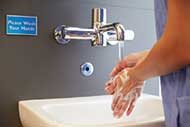A recent study published in the American Journal of Infection Control shows a strong correlation between improved use of an ultraviolet (UV) disinfection program and a decrease in C. difficile rates.
Authors of the study, “Maximizing efficiency in a high occupancy setting to utilize ultraviolet disinfection for isolation rooms,” describe changes made by the Cincinnati Children’s Hospital Medical Center’s infection prevention and control (IPC) and environmental services (EVS) departments to increase use of its two UV robots and increase coverage.
The medical center’s EVS team for inpatient areas is contracted through a third-party vendor that maintains a strong relationship with the in-house IPC team. In 2016, the medical center purchased two UV robots, which a dedicated infection preventionist managed to disinfect rooms. In 2017, the hospital decided to turn the UV disinfection operations over to its EVS team. The EVS team initially managed 1.4 full-time equivalent (FTE) UV technicians and within months increased it to 2.4 FTEs.
“An improvement team was established that included an infection preventionist, the IPC director and an [EVS] manager,” the study authors write. “The group later grew to include an [EVS] data analyst and the [EVS] director. Definitions were established for the types of rooms to prioritize for UV disinfection, and data tracking and reporting frequency were determined. The team met on a biweekly basis to review data and discuss how to improve coverage.”
After moving UV disinfection operations to EVS, disinfection of isolation rooms quickly improved, averaging 70% monthly.
In May 2018, the medical center trained relief UV technicians to fill in for absences of the dedicated technicians. That staffing alteration helped to increase isolation room coverage to an average of 88% monthly, and priority room coverage improved as well.
In addition, the authors found that HAI rates decreased 16% after the new program was implemented.





